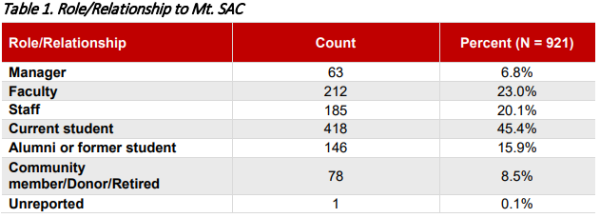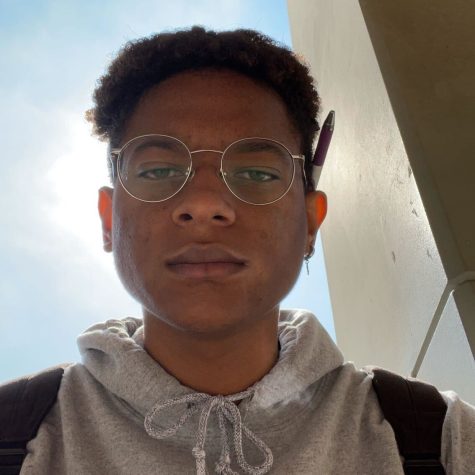Mt. SAC’s iconic Joe Mountie, the college’s controversial mascot for 77 years, is on the cusp of being replaced, marking a new era in the institution’s history.
The motion, approved by the Board of Trustees last September, sparked discussions and controversy as the college community grappled with the decision to say goodbye to Joe Mountie while keeping the “Mounties” moniker intact.
Simultaneously, the First People’s Native Center and the Native American Inter-Tribal Student Alliance are raising their voices to ensure that the college’s new mascot aligns with the diversity and cultural representation the campus holds.
In the open-ended response portion of a survey administered by Mt. SAC, the top reasons from respondents in favor of changing the mascot contended that Mt. SAC needs a new mascot that is current and inclusive. Many believe that Joe Mountie does not represent the diversity, culture or values of the college and student body.
The survey that resulted in this change was administered online for three weeks in June 2021 while classes were still fully online amidst the pandemic.
In those three weeks, 921 individual email accounts of management, faculty, staff, students, college donors and alumni responded.

The mascot’s apparel and moniker were initially challenged due to its controversial involvement in the history of Native Americans’ and Indigenous peoples’ oppression.
According to Uyen Mai, Mt. SAC’s director of marketing and communications, the independent agency tasked with the creation of the new mascot had been selected on Sept. 23, 2023 at the most recent Mascot Development Workgroup meeting.
However, the moniker “Mounties” remains unchanged.
“After much discussion, [the college] then voted 15-2 to change the mascot, Joe Mountie, and 12-5 to keep the moniker, ‘Mounties,’” the Mt. SAC Board of Trustees stated.
According to Mt. SAC’s Board of Trustees, the Mascot Development Workgroup found its vendor, Loma Media, that will illustrate the beginning drafts, listen to campus and community feedback and provide the final mascot designs.
With the necessary contracts to change the mascot ready to go, both Mt. SAC and Loma Media finalized the implementation to the new changes.
The Mascot Development Workgroup consists of a few members from different departments that pertain to anything within student, marketing, academic and athletic affairs. This scope ranges from students, athletic coaches, the academic senate, the marketing manager and many others to work with Loma Media and create an exceptional mascot.
Mai anticipates that Mt. SAC will start accepting mascot submissions from the community before the Fall 2023 semester ends and decide on a new mascot before Summer 2024 to launch in the Fall 2024 semester.
“Our goal right now is to gather feedback in the fall before everyone leaves for the fall, to have a mascot in the spring and then launch it next fall,” Mai said. “Assuming everything stays as is.”
The students enrolled at that time summed up to 45.4% of the survey respondents, translating to 418 current students.
According to Datausa.io, the enrollment of students in credit and noncredit courses in 2021 totaled 51,080 students: with 16,972 full-time enrollment at Mt. SAC and 34,108 registered as part-time enrollment.
This is a noticable discrepancy from the previously totaled 30,959 students Mt. SAC stated were surveyed from the Spring 2021 semester.
When the survey asked if the school should consider changing the mascot, 43.4% responded yes, 39.5% responded no and 17.1% were unsure.

Conversely, when asked about the moniker, the results leaned in the opposite direction.
When asked if the school should consider changing the moniker, 48.1% responded no, 32.9% responded yes and 18.9% were unsure.

The top reasons respondents were against changing the moniker argue that there is a historical connection with current students and alumni; therefore, no reason to change it. The most prevalent response for not changing it was that respondents “like or are proud of the moniker.”
One respondent anonymously wrote about their position on changing the moniker “Mounties” in the open-ended portion of the survey.
“I would be vehemently against changing the name,” a respondent said. “In this age and culture of scraping our history, we need it to stop. Changing it would erase the history of all who were proud to be called Mounties.”
Although the Board of Trustees had now appointed an independent agency to create the new mascot, the same “Mounties” moniker will still be in use.
This change is welcomed by some as a step in the right direction while others believe it is not enough.
One group that shared this sentiment was the First Peoples’ Native Center, a center that opened during the fall of 2022 after the idea to create a dedicated space for Native American and Indigenous students was discussed.
Since its inception, FPNC and the Native American Inter-Tribal Student Alliance have worked together to raise awareness of the contributions and continued presence of Native American and indigenous peoples of the region, as well as combat the racial depiction of Natives in sports, art and education.
The FPNC and NAISA argue the diversity captivated at the present-day halls of Mt. SAC is not accurately represented by the connotations that follow the “Mounties” moniker or Joe Mountie, an older white man with a skinned raccoon hat and musket.
History has a coincidental way of repeating itself.
This is not the first time the mascot has received backlash as individuals who dedicated their lives to addressing similar issues in unique ways that have failed previously.
A member of the Native community who mirrored the goals of the FPNC today was Charlene Teters, an artist and political activist who chose to voice her advocacy and activism for Natives through art.
Teters recently had the opportunity to share with students at Mt. SAC about her trials and tribulations of championing advocacy to bring forth discussion.
During Teters’s time as a student, she had also campaigned for the removal of Native faux mascots and knew that what some students feel today felt all too familiar to herself.
While working on her Master of Fine Arts degree in painting at the University of Illinois, she attended a university basketball game with her two children. The university’s mascot, Chief Illiniwek, was a European American student dressed in pseudo-Native American regalia, dancing around the gym, wearing a headdress and dragging highly respected eagle feathers on the floor.
Her children let out a nervous laugh and sank into their seats.
After that moment, she took her experiences as a woman of the Spokane tribe and used the stereotypes she had received in her lifetime to fuel her art, spark diverse conversation, uplift the next generation and show the importance of self-advocacy.
Teters’s efforts were instrumental in raising awareness and generating support for Chief Illiniwek’s removal, where she utilized live art exhibitions, demonstrations and speeches to combat the misappropriation of Natives at her own school.
She was not the only one to voice her concerns but she was a vocal contributor toward a broader movement and she took her impact seriously.
After nearly 20 years of continuous protests and anti-racism rallies, Chief Illiniwek was removed by the University of Illinois Board of Trustees in 2007.
Teters’s personal experience holds a striking resemblance to what Mt. SAC Native students could feel in silence today.
She used her voice for advocacy, displayed her art and continued consistently toward creating a constructive conversation about hurtful norms, with hopes of sparking change and empowering others to find their own courage and fight for their own inclusivity.
The dehumanizing perception of American Indians is one reason people like Teters and members of the FPNC and NAISA continually move toward the removal of faux Native American imagery through self-advocacy and conversation.
Remember, the Washington Commanders were formerly known as the Washington Redskins and their baseball counterpart Cleveland Indians are now the Cleveland Guardians.
A change could be a quick and easy fix or a sensitive and intimate discussion that sometimes leaves all participating parties at a stalemate.
If marginalized groups do not voice their concerns or force the public to engage in diverse conversations, change will never come and the masses won’t know.
To continue combating hurtful stereotypes in today’s time, FPNC and NAISA are voicing their advocacy for the removal of Mt. SAC’s mascot from campus halls to make way for a newer and more appropriate representative of the school’s population.
Vice President of Student Services, Audrey Yamagata-Noji, who read an article that college enrollment of native students had dropped 60% over the last 20 years, wanted to create an area for the Native American Inter-Tribal Student Alliance NAISA and other indigenous students to receive academic support and build like-minded connections.
In support of Yamagata-Noji’s idea, Dr. Frances Borella, an anthropology professor and FPNC faculty advisor, has been a hearty contributor since 1999 toward creating a space like FPNC for Native American and indigenous students.
For over two decades, Borella had held unofficial celebrations for the graduating Native American and Indigenous students of Mt.SAC out of her own home, classroom and heart.
Every Friday from 11:30 a.m. to 1 p.m., students and faculty could arrive at Borella’s classroom in Bldg. 61 2312 and converse with the NASIA members to learn more about their suppressed history and what could be done about it.
Last spring semester, Borella witnessed the bounty of her and the administration’s hard work and dedication. NAISA held the first official Native American student recognition ceremony where four graduating students from NAISA were individually recognized in front of their fellow peers.
It is clear that advocacy for the indigenous peoples and student support work hand in hand at the FPNC. The makeshift office space is now a permanent hallmark that welcomes students as it approaches its first anniversary in November.
Little Crow, a history major who has been involved in NAISA for over a decade, does not see a reason the college’s moniker should have ever been the Mounties, especially after learning the history of Canadian mountaineers and the Tongva land the institute is built on.
“I don’t know the history and I’m still confused about why Mounties,” Little Crow said. “If it was where the founder or founders [of Mt.SAC] were a Mountie or was from Canada then that would make sense and I could see the link to that, but there is no link to that and I always found that unusual.”
Mai urges everyone to keep a lookout on social media, bulletins and school emails for when the campus and community can cast their mascot submissions or vote on the final mascot to include your thoughts and input.
“We are really looking forward to getting a lot of feedback on the mascot, our goal is to find something powerful that the community can rally behind and we are hopeful we can achieve that for them,” Mai said.
To stay up to date with Mascot Development Workgroup, follow their process or even see past meetings, click here for their website.
The FPNC also offers student-centered services like counseling, tutoring for writing, transfer application assistance and social worker referrals for any member that joins and is not exclusive to solely native students.
More information can be found at the FPNC’s website or by contacting them at (909) 274-4378.



